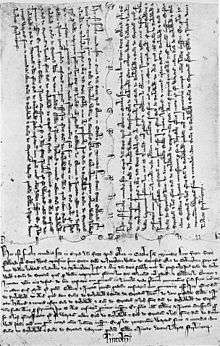Chirograph

A chirograph is a medieval document, which has been written in duplicate, triplicate or very occasionally quadruplicate on a single piece of parchment, with the Latin word "chirographum" (occasionally replaced by some other term) written across the middle, and then cut through to separate the parts.
Etymology
The Latin word "chirographum", often spelled "cirographum" or "cyrographum" in the medieval period, is derived from the Greek χειρόγραϕον, and simply means "handwritten".
Description
The intention of the chirograph was to produce two (or more) identical written copies of a legal agreement, that could be retained by each party to the transaction, and if necessary verified at a later date through comparison with one another. The cut itself would generally be made with a wavy or serrated edge, running through the word "chirographum", to allow the copies to be matched physically as a safeguard against forgery. The earliest surviving portion of a chirograph in England dates from the middle of the ninth century.[1]
The practice of separating the copies with an irregular cut also gave rise to the description of the documents as "indentures", since the edges would be said to be "indented".[2] In the post-medieval period, as legal documents grew in length and complexity, it became impractical to fit two duplicate texts onto a single sheet of parchment. It therefore became more usual to make the two copies on two or more separate sheets, although the top edges were still cut with a symbolic wavy line.[3]
Ecclesiastical use
A more restricted use of the term "chirograph" is to describe a papal decree whose circulation—unlike an encyclical—is limited to the Roman curia.[4]
A recent example of a chirograph is that issued by Pope Francis, announced on June 26, 2013, that was established to investigate the activities of the Institute for the Works of Religion (the so-called "Vatican Bank"). The document was "an instrument under canon law giving the commission legal force. According to the text, the broad aim of the commission is to help ensure that 'the principles of the Gospel also permeate activities of an economic and financial nature.'"[5]
See also
- Fine of lands, or final concord, a type of property conveyance in chirograph form common in medieval and post-medieval England
- Tally stick, or split tally, a comparable system of creating matching copies of simple accounting records on a split stick
References
- Lowe, Kathryn A. (1997). "Lay Literacy in Anglo-Saxon England: the Development of the Chirograph". In Pulsiano, P.; Treharne, E. Anglo Saxon Manuscripts and their Heritage. Aldershot: Ashgate. pp. 161–204.
- Pollard, John F. (2005). Money and the Rise of the Modern Papacy: Financing the Vatican, 1850–1950. Cambridge: Cambridge University Press. ISBN 0521812046.
Notes
- ↑ Lowe, Kathryn A. (1997). "Lay Literacy in Anglo-Saxon England: the Development of the Chirograph". In Pulsiano, P.; Treharne, E. Anglo Saxon Manuscripts and their Heritage. Aldershot: Ashgate. pp. 161–204.
- ↑ Brown, M. P. (1990). A Guide To Western Historical Scripts From Antiquity to 1600. London: British Library. pp. 78–9. ISBN 0712301771.
- ↑ Alcock, N. W. (1986). Old Title Deeds: a guide for local and family historians. Chichester: Phillimore. pp. 35–6, 58. ISBN 0-85033-593-0.
- ↑ Pollard, p. xvi.
- ↑ Glatz, Carol; Wooden, Cindy (26 June 2013). "Pope creates commission to study activities, mission of Vatican bank". National Catholic Reporter. Retrieved 22 July 2016.
External links
- Chirographs, Indentures and Final Concords Medieval Writing. Retrieved on August 7 2008.
- Vatican page on Chirographs